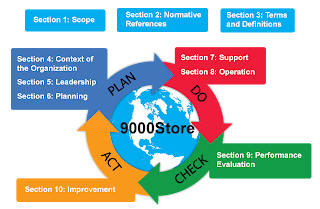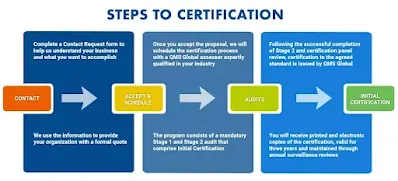Introduction to ISO 9001:2015-Quality Management System
Certification of organizations
ISO 9000 vs ISO 9001
What is ISO 9001:2008?
What is ISO 9001 and other standards?
Other standards in the ISO 9000 family include ISO 9004, which focuses on performance improvement, and ISO 9010, which focuses on quality management in service industries.
What is the purpose of ISO 9001?
Why is ISO 9001 important?
What are the ISO 9001 requirements?
The ISO 9001 requirements include a number of different guidelines and requirements for quality management systems. These include:
Leadership: Organizations must have a clear and effective leadership structure in place that is dedicated to quality management to meet requirements for ISO 9001.
Planning: Organizations must develop and implement a quality management plan that outlines their goals, objectives, and strategies for achieving them to meet requirements for ISO 9001.
Support: Organizations must provide the necessary resources and support to ensure that their quality management system is effective to meet requirements for ISO 9001.
Operation: Organizations must implement and maintain processes and procedures that support their quality management system to meet requirements for ISO 9001.
Performance Evaluation: Organizations must regularly evaluate the performance of their quality management system and identify areas for improvement to meet requirements for ISO 9001.
Improvement: Organizations must take corrective and preventive actions to address any issues or non-conformities identified in their quality management system to meet requirements for ISO 9001.
Documentation: Organizations must have a documented quality management system that outlines their processes, procedures, context of the organization and policies to meet requirements for ISO 9001.
Auditing: Organizations must be audited by an independent third-party organization to ensure that they are in compliance with the standard to meet requirements for ISO 9001.
These are the main requirements that organizations must meet to be certified to ISO 9001. However, there are additional requirements and guidelines that organizations must follow depending on their context of the organization, specific industry and needs.
How is ISO 9001 implemented?
ISO 9001 implementation typically involves several steps, including:
Preparation: This includes reviewing the standard, identifying the scope of quality management system, and determining the resources needed for implementation of ISO 9001.
Documentation: Organizations must develop and document their quality management system, including policies, procedures, context of the organization and work instructions.
Implementation: Organizations must implement their quality management system ISO 9001, including training employees on the new processes and procedures.
Auditing: Organizations must conduct internal audits to ensure that their quality management system ISO 9001 is being implemented and followed correctly.
Certification: Organizations must be certified by an independent third-party organization to ensure that they are in compliance with ISO 9001 quality management system standard.
Continual improvement: Organizations must continuously monitor and improve their quality management system ISO 9001 to ensure that it stays effective and efficient.
It is important to note that the implementation process can vary depending on the size and complexity of the organization, its products and services, as well as the specific industry and requirements
Some of the organizations may choose to work with a consultant or a certification body to guide them through the process.
It is also important to understand that ISO 9001 implementation is not a one-time event but it should be an ongoing process of continuous improvement.
Organizations should monitor the implementation of the standard and make adjustments as necessary.
How do I get ISO 9001 certified?
Getting ISO 9001 certified involves several steps, including:
- Preparation: This includes reviewing the standard, identifying the scope of quality management system, and determining the resources needed for implementation.
- Documentation: Organizations must develop and document their quality management system, including policies, procedures, work instructions as well as their products and services.
- Implementation: Organizations must implement their quality management system, including training employees on the new processes and procedures.
- Auditing: Organizations must conduct internal audits to ensure that their quality management system is being implemented and followed correctly.
- Certification audit: Organizations must be audited by an independent third-party certification body to ensure that they are in compliance with the standard.
- Continuous improvement: Organizations must continuously monitor and improve their quality management system to ensure that it stays effective and efficient.
- Certification: Upon successful certification audit, the organizations will be certified to ISO 9001.
Steps for a company to get ISO 9001 certified
Review the standard and identify the scope of the quality management system
Develop and document the policies, procedures, and work instructions of the quality management system as well as products and services.
Implement the quality management system, including training employees of the organization.
Conduct internal audits to ensure compliance with the standard
Undergo a certification audit by an independent third-party certification body
Continuously monitor and improve the quality management system of the organization to maintain certification
Upon successful certification, the organization will be certified to ISO 9001.
What is the current ISO 9001 standard?
What is a quality management system?
What is QMS certification?
Quality management (QM) is a systematic approach to managing an organization's processes, products and services to ensure they meet customer expectations and requirements. Implementing a QM system, such as ISO 9001, can bring significant benefits to an organization, including:
Improved customer satisfaction: A QM system focuses on understanding and meeting customer needs and requirements.
This can lead to increased customer satisfaction and loyalty, which can ultimately lead to increased sales and revenue.
Increased efficiency and reduced costs: By implementing a QM system, organizations can identify and eliminate inefficiencies and waste in their processes.
This can lead to cost savings and increased productivity.
Enhanced reputation and credibility: Organizations that have a QM system in place and are certified to a standard such as ISO 9001 are seen as being committed to quality and continuous improvement.
This can enhance the organization's reputation and credibility, which can lead to increased business opportunities and partnerships.
Compliance with regulations: A QM system can help organizations ensure compliance with relevant laws, regulations, and industry standards.
This can reduce the risk of penalties or legal action.
Improved employee engagement and satisfaction: A QM system can empower employees to take ownership of their work and be involved in the continuous improvement process.
This can lead to increased employee engagement and satisfaction, which can ultimately result in increased productivity and reduced turnover.
Overall, implementing a QM system can bring significant business benefits to organizations, including increased customer satisfaction, reduced costs, enhanced reputation, compliance with regulations, and improved employee engagement and satisfaction.
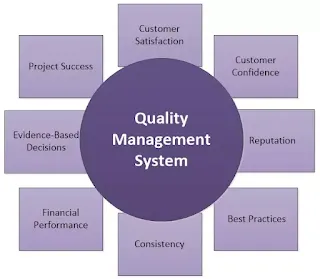
Quality management principles
Quality management principles are a set of guidelines that organizations can follow to ensure they are effectively managing their processes and products to meet customer requirements and expectations. The principles of quality management are defined in ISO 9000 and include:
Customer focus: Organizations should understand and meet the needs and expectations of their customers in order to meet their requirements.
This principle emphasizes the importance of putting the customer first and ensuring their satisfaction.
Leadership: Organizations should have effective leadership in place to provide direction and support for the quality management system.
This principle emphasizes the importance of having strong leadership that can drive the organization's commitment to quality and continuous improvement.
Involvement of people: Organizations should involve employees at all levels in the quality management system.
This principle emphasizes the importance of employee engagement and empowerment in the continuous improvement process.
Process approach: Organizations should manage their processes in a systematic and consistent manner.
This principle emphasizes the importance of understanding and managing the processes that make up the organization's operations.
System approach to management: Organizations should manage their quality management system as a whole, with a focus on the interactions and interdependencies between processes.
This principle emphasizes the importance of understanding the organization's overall operations and how they work together.
Continual improvement: Organizations should continuously improve their quality management system and processes.
This principle emphasizes the importance of ongoing improvement and the need to always strive for better performance.
Factual approach to decision making: Organizations should make decisions based on facts and data, rather than opinions or assumptions.
This principle emphasizes the importance of using data and evidence to inform decisions and improve performance.
Mutually beneficial supplier relationships: Organizations should develop mutually beneficial relationships with suppliers and other stakeholders.
This principle emphasizes the importance of working together with suppliers and other stakeholders to achieve a common goal of meeting customer requirements and expectations.
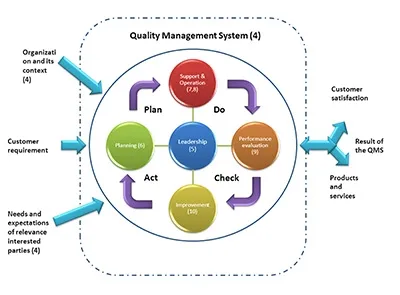
What is ISO 9001 – Quality management systems?
ISO 9001 Requirements for Quality Management System
ISO 9001 sets out the requirements for quality management system (QMS) that organizations can use to improve their overall performance and meet customer requirements. These requirements are divided into seven main sections:
Scope:
This section defines the scope of the QMS and how it applies to the organization.
Normative reference:
This section lists any other standards or documents that are referred to within the ISO 9001 standard.
Terms and definitions:
This section provides definitions for key terms used within the standard.
Quality management system:
This section outlines the requirements for the QMS, including the need for a process approach, the importance of leadership and involvement of people, and the need for continual improvement.
Management responsibility:
This section outlines the responsibilities of top management for the QMS, including the need for a policy, objectives and a commitment to customer satisfaction.
Resource management:
This section outlines the requirements for the management of resources, including human resources, infrastructure and the work environment.
Product realization:
This section outlines the requirements for the realization of products or services, including the need for planning, design and development, purchasing, production and service delivery, and monitoring and measurement.
Measurement, analysis and improvement:
This section outlines the requirements for monitoring, measuring and analyzing the QMS, and for making improvements as necessary.
In order to become certified to the ISO 9001 standard, organizations must demonstrate that they meet all of these requirements and maintain their QMS to a high standard.
Implementation of a QMS with IMS2 methodology
IMS2 methodology (Integrated Management System) is a systematic approach to implementing and integrating multiple management systems, such as ISO 9001, ISO 14001 (Environmental management) and OHSAS 18001 (Occupational health and safety management) within an organization.
The implementation of a QMS with IMS2 methodology begins with a gap analysis to determine the current state of the organization's management systems.
This includes identifying any existing processes, procedures and controls in place, and evaluating how well they align with the requirements of ISO 9001.
The next step is to develop a plan for implementing the QMS, including identifying the resources required, assigning responsibilities, and developing a timeline for completion.
This plan should be reviewed and approved by top management to ensure their full commitment and support.
The actual implementation of the QMS is then carried out, with the organization's processes, procedures, and controls being updated and aligned with the requirements of iso 9001.
Training is also provided to all employees to ensure they understand their roles and responsibilities within the QMS.
Once the QMS is in place, it is important to monitor and measure its effectiveness, and make any necessary improvements.
This can be done through internal audits, management reviews of the organization, and monitoring customer feedback.
Risk based approach
Is ISO certification mandatory?
What are the ISO 9001 standards?
What is the purpose of ISO 9001 ?
What are the main core concept in ISO 9001?
How is ISO 9001 implemented?
Frequently Asked Questions:
- How
to apply ISO 9001? To apply for ISO 9001 certification, follow these
steps:
- Identify
the scope and processes of your organization.
- Implement
a quality management system according to ISO 9001 requirements.
- Conduct
internal audits to ensure compliance.
- Contact
ISO Certification in Nepal Pvt. Ltd. for an external audit.
- After
successful evaluation, receive ISO 9001 certification.
- What
is ISO 9001? ISO 9001 is an international standard that sets the
requirements for a quality management system. It focuses on meeting
customer expectations, continuous improvement, and enhancing overall
performance.
- What
is the difference between ISO 9000 and ISO 9001? ISO 9000 is a family
of standards that provides guidelines for quality management systems,
while ISO 9001 specifically outlines the requirements for an
organization's quality management system.
- What
does ISO 9001 stand for? ISO 9001 stands for the International
Organization for Standardization (ISO) standard number 9001, which defines
the requirements for a quality management system.
- What
is ISO 9001 certification? ISO 9001 certification is a formal
recognition that an organization's quality management system meets the
requirements of ISO 9001. It signifies the organization's commitment to
delivering quality products and services.
- What
is ISO 9001:2008? ISO 9001:2008 was a previous version of the ISO 9001
standard. However, it has been replaced by ISO 9001:2015, which is the
current version.
- What
is ISO 9001:2015? ISO 9001:2015 is the latest version of the ISO 9001
standard. It sets out the criteria for a quality management system based
on a process approach and risk-based thinking.
- What
is ISO 9001 standard? ISO 9001 is an international standard that
specifies the requirements for a quality management system. It helps
organizations consistently provide products and services that meet
customer and regulatory requirements.
- How
to begin ISO 9001:2015? To start implementing ISO 9001:2015, follow
these steps:
- Familiarize
yourself with the standard's requirements.
- Identify
the processes and interactions within your organization.
- Develop
and document a quality management system.
- Train
employees on the new processes and requirements.
- How
to check the validity of ISO 9001:2008? ISO 9001:2008 is no longer
valid, as it has been replaced by ISO 9001:2015. Organizations seeking
certification should adhere to the requirements of ISO 9001:2015.
- How
to get ISO 9001 certification in Nepal? To obtain ISO 9001
certification in Nepal:
- Develop
and implement a quality management system.
- Conduct
internal audits to ensure compliance.
- Contact
ISO Certification in Nepal Pvt. Ltd. for an external audit.
- After
a successful evaluation, receive ISO 9001 certification.
- What
does ISO 9001 certification mean? ISO 9001 certification indicates
that an organization has a robust quality management system in place,
demonstrating its commitment to delivering quality products and services
to customers.
- What
does ISO 9001 mean to employees? ISO 9001 provides employees with
clear guidelines and procedures to follow, fostering a culture of quality,
continuous improvement, and customer satisfaction.
- What
is ISO 9001's major feature? The major feature of ISO 9001 is its
process approach, which emphasizes the systematic management of processes
to ensure consistent product/service quality and customer satisfaction.
- What
is the difference between ISO 9001 and ISO 22000? ISO 9001 focuses on
general quality management across industries, while ISO 22000 specifically
addresses food safety management systems in the food industry.
- Where do I start ISO 9001:2015? To start with ISO 9001:2015, identify the scope of your quality management system, understand the requirements of the standard, and develop a plan to implement the necessary processes and procedures.
It is important to work with a reputable ISO consultant like ISO Certification in Nepal Pvt. Ltd. that can provide cost effective expert guidance and support to your organization throughout the process of ISO 9001 implementation. We are the leading ISO System Certification body in Nepal. We will help an organization to understand requirements, implement the standard and ensure that your company is in compliance with any ISO standards. Besides to ISO 9001 quality management system, we also provide ISO 14001( Environmental management System certification) , ISO 22000(Food Safety Management System Certification) ISO 45001 Occupational health and safety management system , ISO 27001 Information Security Management System . ISO/IEC 17025 Testing and calibration laboratories Organic Certification in Nepal. If you have any queries as well as if you want to get your organization to be ISO Certified, please call 9840525565 to get free consultation on ISO Certification service and know which ISO standards is best for your organization.
.webp)
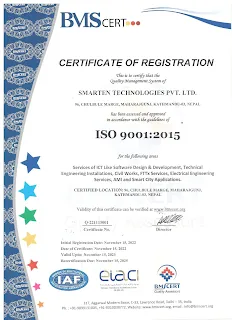

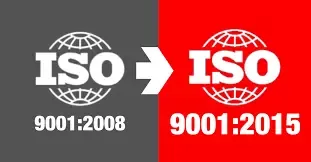
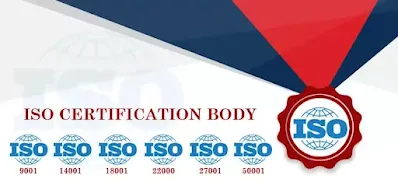
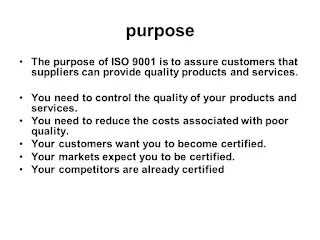
.webp)
